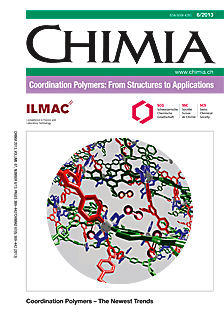Coordination Polymers and Metal–Organic Frameworks Derived from 4,4'-Dicarboxy-2,2'-bipyridine and 4,4',6,6'-Tetracarboxy-2,2'-bipyridine Ligands: A Personal Perspective
DOI:
https://doi.org/10.2533/chimia.2013.403Keywords:
2,2'-bipyridine, Coordination polymer, Ligand synthesis, Metal–organic framework, Sorption propertiesAbstract
Presented herein is a personal overview of some of the contributions we have made over recent years to coordination polymer chemistry employing 2,2'-bipyridine-polycarboxylic acid ligands in conjunction with first row transition, main group or lanthanide metal ions. Primarily the discussion is centred upon the two ligands with which we have enjoyed the most success: 4,4'-dicarboxy-2,2'-bipyridine (4,4'-H2dcbp) and 4,4',6,6'-tetracarboxy-2,2'-bipyridine (4,4',6,6'-H4tcbp). Initial discussion is focused upon the synthetic aspects of ligand formation and their structural characterisation and then moves on to the synthesis of metal complexes incorporating these ligands and the coordination polymers they form. Where possible the discussion is presented from a synthetic and structural perspective with highlight given to the pertinent properties of the coordination polymers formed e.g. thermal behaviour, magnetic, luminescent or small molecule sorption properties. We end the review with some conclusions and highlight some current work with a view to future research.Downloads
Published
2013-06-26
Issue
Section
Scientific Articles
License
Copyright (c) 2013 Swiss Chemical Society

This work is licensed under a Creative Commons Attribution-NonCommercial 4.0 International License.
How to Cite
[1]
P. E. Kruger, Chimia 2013, 67, 403, DOI: 10.2533/chimia.2013.403.







